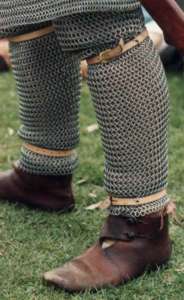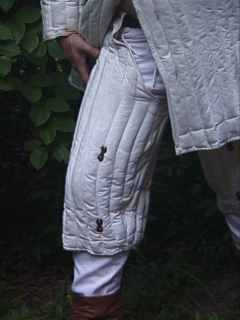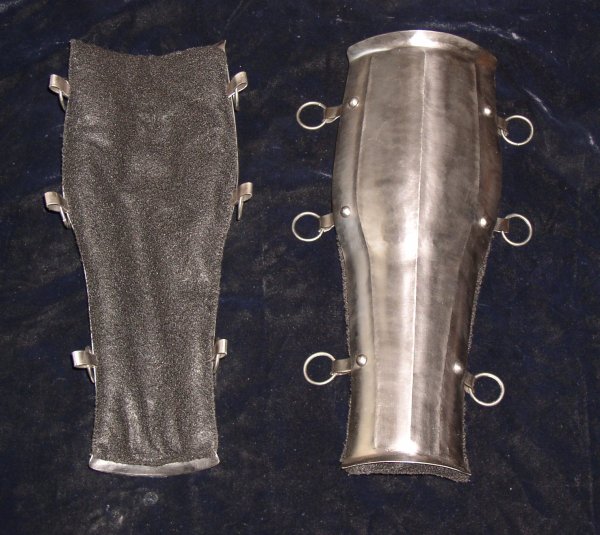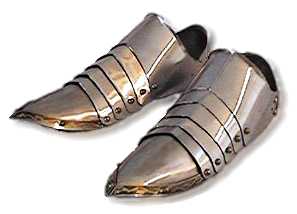Leg Armor
Chausses
(IPA: /ʃoʊs/; French: [ʃos]) are armour for the legs, usually made from mail. They could extend to the knee or cover the entire leg. Chausses were the standard type of metal leg armour during most of the European Middle Ages. Chausses offered flexible protection that was effective against slashing weapons. However, the wearer felt the full force of crushing blows.
Reinforcing plates called poleyns began to supplement mail armour in the 13th century. One of the first locations to see this protection was the knee. Steel shin plates called schynbalds came into use during the final quarter of the century. Unlike greaves, schynbalds protected only the front of the lower leg. These early plate additions were worn over chausses and held in place with leather straps. Chausses became obsolete in the 14th century as plate armour developed.
Chausses were also worn as a woollen legging with layers, as part of civilian dress, and as a gamboissed (padded) garment for chainmail.
Cuisses
Cuisses are a form of medieval armor worn to protect the thigh. The word is the plural of the French word cuisse meaning 'thigh'. While the skirt of a maille shirt or tassets of a cuirass could protect the upper legs from above, a thrust from below could avoid these defenses. Thus, cuisses were worn on the thighs to protect from such blows. Padded cuisses made in a similar way to a gambeson were commonly worn by knights in the 12th and 13th Centuries, usually over chausses and may have had poleyns directly attached to them.
Cuisses could also be made of studded or splinted leather, but by the Late Middle Ages they were typically a form plate armour.
Greaves
A greave (from 12th century French greve "shin", of uncertain origin) is a piece of armour that protects the leg. Often in matched pairs (a pair of greaves), greaves may be constructed of materials ranging from padded cloth to steel plate. Some designs protect only the lower leg (a half-greave) or extend upwards to protect the thigh.
Greaves are most commonly found in the armor of heavy infantry, usually from ancient times. Greek hoplites wore a bronze greave on each leg. Triarii, the better equipped soldiers of the pre-Marian Roman Republic, wore greaves on both shins reminiscent of the Ancient Greeks. Principes and hastati often only wore one greave (on their left leg) or none. The Roman Centurions wore altered greaves from the standard Roman uniform. Later Imperial legionnaires did not wear greaves, except for the centurions who retained them.
In the Middle Ages, greaves eventually developed to protect the back of the legs as well and these were called full greaves (the style which only covered the front became known as half-greaves or demi-greaves).
Knee Armor
Poleyn
The poleyn was a component of Medieval and Renaissance armor that protected the knee. During the transition from mail armor to plate armor, this was among the earliest plate components to develop. They first appeared in the mid-thirteenth century and remained in use until the early seventeenth century when firearms made them obsolete.
The specifics of poleyn design varied considerably over that period. The earliest poleyns were strapped over mail chausses. Late fourteenth century and early fifteenth century poleyns usually attached to padded leggings with leather buckles and incorporated goussets. During the fifteenth century poleyns developed an articulated construction that attached to the cuisses and schynbalds or greaves. A characteristic of late fifteenth century gothic armor was a projection that guarded the side of the knee.
Foot Armor
Sabaton
A Sabaton or solleret is part of a Knight's armour that covers the foot. Fifteenth century sabatons typically end in a tapered point well past the actual toes of the wearer's foot. Sabatons of the first half of sixteenth century end at the tip of the toe and may be wider than the actual foot.
According Funccens princes and dukes allowed to have toes of gothic sabatons 2.5 feet long, lords (barons and higher) 2 feet long, gentry 1 foot long.



